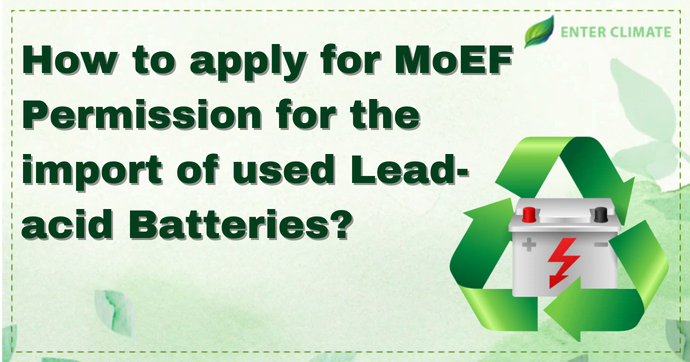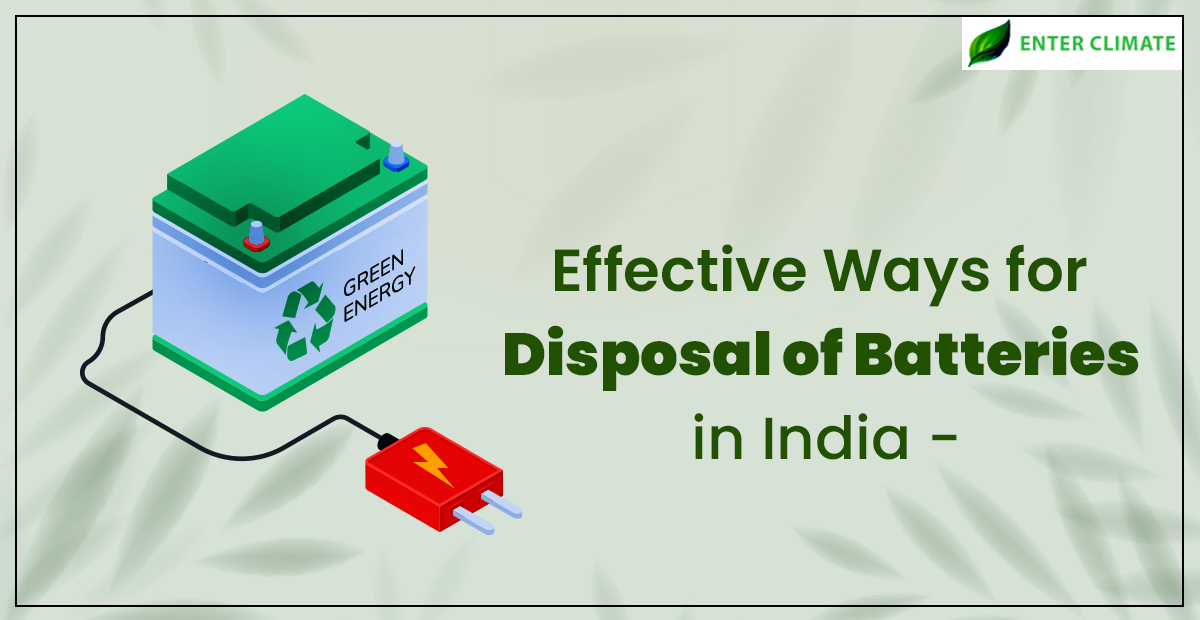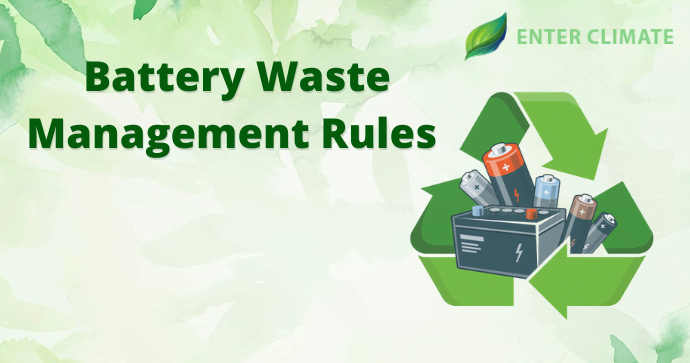How to apply for MoEF permission for the import of used lead-acid batteries?
 28 Nov, 2022
28 Nov, 2022 
A heavy metal, lead finds usage in a majority of things. About 70% of the lead globally is used for manufacturing lead-acid batteries (LABs). These batteries go into power back-ups and automobiles. Lead-acid batteries are generally preferred because these tend to be the most recycled consumer product. Around ninety-eight per cent of all battery lead is recycled. On average, used lead-acid batteries (ULABs) have 10.5 kg of lead. This acts as a major source of secondary lead, and hence, the import of lead-acid batteries becomes necessary. To do so, obtaining the Ministry of Environment, Forest and Climate Change (MoEF&CC) permission to import used lead-acid batteries is necessary. Read on to learn the detailed process.
Introduction of the Hazardous and Other Wastes (Management & Transboundary Movement) Rules, 2016
To promote the import of the used lead-acid battery in an environmentally sound manner, MoEF came up with the Hazardous and Other Wastes (Management & Transboundary Movement) Rules, 2016. The rules place the used lead acid battery, including grid plates and other lead scraps/ashes/residues not covered under Batteries (Management and Handling) Rules, 2001, under the list of commonly recyclable hazardous wastes. Besides setting the roles and responsibilities, the rules describe the process of applying for MoEF permission to import used lead-acid batteries.
Classification according to the Battery Waste Management Rules
Importing used lead-acid batteries is covered in the HWM rules and the Battery Waste Management Rules.
So, according to Schedule-I of the BWM rules, 2020, the batteries are distinguished into two categories –
| Classification | Type of battery |
| Primary cells or Disposable batteries | Alkaline batteries |
| Secondary cells or Rechargeable batteries | Lead acid batteries |
Usage of lead-acid batteries
Before obtaining the MoEF permission to import used lead-acid batteries, it is vital to understand their uses. So, the heavy-weight lead acid batteries are used for backup power supply for high-end servers, starting, lighting, and ignition systems (SLI) of automobiles, telephone exchanges, personal computers and in off-grid homes with inverters. Besides, portable emergency lights also use lead-acid batteries.
Responsibilities of manufacturer, importer, assembler and re-conditioner
As per the BWM rules, it must be the responsibility of an importer, manufacturer, assembler and re-conditioner to:
- Obtain the MoEF permission for the import of used lead-acid batteries;
- make sure that the used batteries collected back are of the exact specifications and type as that of the new batteries sold;
- Guarantee that the used batteries are collected back according to the schedule against new batteries sold, excluding those sold to bulk consumer(s) and original equipment manufacturer;
- make sure that used batteries collected are sent only to the registered recyclers;
- Establish collection centres either jointly or individually at several places for the collection of used batteries from dealers or consumers;
- Make sure that necessary arrangements are made with dealers for safe transportation to the premises of registered recyclers from collection centres;
- Create public awareness via publications, advertisements, posters or by other means related to the following:
- the obligation of consumers to deliver used batteries at collection centres or return them to the dealers;
- hazards of lead, cadmium and mercury; (other elements)
- addresses of dealers and collection centres;
- instructions for handling and disposal of the equipment after its use, along with the don’ts and do’s;
- details on hazards of improper handling, disposal, accidental breakage, damage or improper recycling of batteries.
- Ensure that no harm happens to the environment during the transportation of used batteries. Furthermore, no acid should be drained in case of import of used lead acid batteries;
- Buy recycled lead only from registered recyclers;
- Use the international recycling sign on the batteries;
- Bring to the attention of the MoEF or the state board any violations by the dealers.
Responsibility of the dealers
To obtain permission for the import of used lead acid batteries, it must be ensured that a dealer fulfils the following responsibilities –
- Make sure that the count of the used lead-acid batteries replaces 100% of new lead-acid batteries sold to the consumer. New batteries must be sold on proper GST invoice; and
- Guarantee that no damage is caused to the environment during transportation and storage of used batteries, and no acid should be drained in case of lead-acid batteries.
Responsibility of collection centres
- Collection centres must ensure that no damage is caused to the environment during the transportation and storage of battery waste. Also, no acid should be drained in the case of lead-acid batteries.
Responsibility of importer
- For obtaining the MoEF permission to import used lead-acid batteries, it must be understood that, notably, the rules are based on the concept of EPR.
- Here, the producers, including importers, of batteries are responsible for recycling/refurbishment and collection of waste batteries. The rules further mandate the use of recovered materials from waste in new batteries.
- Also, EPR mandates that all waste batteries be sent and collected for refurbishment/recycling. Furthermore, it prohibits disposal in landfills and incineration. To meet the EPR obligations, producers must involve themselves or authorise any other entity to collect, refurbish or recycle waste batteries.
- It shall be the responsibility of an importer to
- an appeal will lie against any order of refusal or suspension of registration passed by the Member Secretary of the CPCB or any other officer appointed by CPCB;
- The importer must get registered according to Form-2(C) with CPCB for five years and a provision of cancellation for failure in the collection of the mandated count of used batteries according to the said rules, non-submission of timely annual returns to PCC/SPCB with a copy to CPCB, the registration renewal must be according to the compliance status, given that the registration granted to the importer must not be cancelled unless he has been offered a reasonable opportunity of hearing; and
- The appeal must be in writing and attached with a copy of the order appealed against and shall be made within thirty days from the date of passing the order.
Targets for Lead Acid Batteries
| No. | Year | Battery-Waste Collection Target (Number/Weight) |
| (i) | During the first two years of rules implementation | 90% of the quantity |
| (ii) | During the third and fourth years of implementation of rules | 100% of the quantity |
- Environmental compensation will be levied on the principle of Polluter Pays Principle for non-fulfilment of EPR responsibilities, targets and obligations stipulated under the rules.
Liability of occupier, exporter/ importer and operator of a disposal facility
- The importer, occupier or exporter and operator of the disposal unit stand liable for all the harm caused to the third party or environment because of the improper management and handling of the hazardous and other waste.
- Furthermore, the occupier and the operator stand responsible for paying financial penalties as imposed for any violation of the norms.
Strategy for import of hazardous and other wastes
Again, before obtaining MoEF permission to import used batteries, it is essential to understand the strategy for importing hazardous waste.
- The import of hazardous and other wastes, including used lead acid batteries from any nation, will be allowed only for recovery, recycling, reuse, and co-processing.
- No import of hazardous and other wastes to India from any nation for disposal will be allowed.
- MoEF permission to import used lead-acid batteries and other wastes in Part B of Schedule III is mandated to the actual users.
- Importing hazardous waste in Part A of Schedule III (including waste lead acid batteries) is permitted to actual users with the prior informed consent of the exporting nation and will require the permission of the MoEF&CC.
- Importing hazardous and other wastes specified in Schedule VI is not allowed.
- Importing other wastes in Part D of Schedule III is allowed according to the process given in Rule 13.
- The import of hazardous and other wastes not mentioned in Schedule III but exhibiting the hazardous characteristics mentioned in Part C of Schedule III will require prior written permission of the MoEF before it is imported to India.
Procedure to obtain MoEF permission for import of used lead acid batteries and hazardous and other wastes
- To obtain MoEF permission to import used lead-acid batteries and hazardous and other wastes specified in Part A and B of Schedule III, actual users must apply for Form 5. The required documents must accompany the application to the ministry for the suggested import and the prior informed consent of the exporting nation related to the Part A of Schedule III waste.
- The user must submit a copy of the application simultaneously to the concerned SPCB for details. Moreover, the acknowledgement regarding this from the concerned SPCB must be submitted along with the application to the ministry.
- Upon receiving the complete application regarding Part A and B of Schedule III, the ministry then examines the application, considering the observations and comments received from the SPCB. MoEF then may grant the permission for import within two months if the importer has –
- adequate arrangements for the disposal and treatment of wastes generated;
- the environmentally sound facilities;
- prior informed consent from the exporting nation in case of Part A of Schedule III wastes; and
- a valid authorisation and consent from the SPCB.
- MoEF&CC must forward a copy of the permission to the specific Port and Customs authorities, CPCB and the concerned SPCB to ensure compliance regarding their specific functions mentioned in Schedule VII.
- The importer must maintain records of the hazardous and other waste he imported in Form 3. The record so maintained should be made available for inspection.
- Samples of hazardous & other wastes being imported for research and development or testing purposes up to 1000 ml or 1000 gm must be exempted from taking permission for import.
- The importer of the hazardous & other wastes must file an annual return in Form 4 to the SPCB on or before the 30th day of June following the financial year associated with that return.
- The Port and Customs authorities must ensure that the movement document in Form 6 accompanies the shipment. The test report of analysis of the consignment, and waste, wherever applicable, from a recognised or accredited lab or by the exporting nation. In case of any doubt, the customs may verify the analysis.
Points to remember before applying for MoEF permission for the import of used lead-acid batteries
- To obtain MoEF permission to import used lead-acid batteries, the applicant must browse the ministry’s official website.
- An individual or business entity planning to transit and import hazardous wastes such as used lead acid batteries must follow all the mandated norms.
- Proper hazardous waste management must be followed. This includes collection, recycling, treatment, disposal and transportation of wastes.
- The business entity or an individual involved in the import requires MoEF permission to import used lead acid batteries. No traders seeking to import hazardous wastes like lead-acid batteries, lead, paper, scrap plastic, rubber, etc., can do so without the ministry’s permission.
The detailed process for obtaining the MoEF permission for the import of used lead-acid batteries
- The duly filled application for MoEF permission to import used lead-acid batteries must be addressed to the Joint Director, Hazardous Substances Management Division, Jal Block, 2nd Floor, Indira Paryavaran Bhawan, New Delhi-110003.
- Post the 73rd meeting of the Expert Committee, all applications seeking import/export authorisations under Hazardous and other Wastes Rules, 2016, must be submitted online. This must be done through the ministry’s waste management portal. The detailed steps to submit the applications are available on the ministry’s website.
- The applicants must browse the ministry’s online portal for meeting notices, agendas and other such information.
- Ensure to fill in the contact person’s e-mail address and phone number in the application.
- For any queries, the applicants can contact the Ministry on working days.
- First-time applicants must attend the Expert Committee Meeting for a technical discussion.
- After the acceptance of the online application by MoEF, the applicants must submit a photocopy of the application along with the entire set of documents to the Ministry via post or in person. However, the application must be submitted before the commencement of the scheduled meeting of the Expert Committee.
- After applying the MOEF portal, the EC checks it.
- If any other document or clarification is needed, EC notifies the document insufficiency. This document must be submitted online.
- After this, the EC notifies the schedule for online meetings with the applicants.
- The applicants invited for the presentation must ensure their presence within two subsequent meetings of the Expert Committee.
- Later, the committee decides whether or not to inspect the applicant’s premises. A further decision is also made on whether to conduct the inspection online or physically.
- Once the inspection decision is made, the ministry notifies instructions to the CPCB of the same.
- The CPCB may, in turn, instruct the SPCB to perform the said inspection.
- After the aforementioned process, the ministry will either issue the NOC for importing lead-acid batteries or reject the application after offering the reasons for this in writing. The applicant can apply for the same again later on.
Documents required to obtain MoEF permission for the import of used lead-acid batteries
- Justification for import of used lead-acid batteries.
- Valid Consent to Operate (CTO) under Water Act, 1974 & Air Act, 1981[1].
- Valid authorisation under Hazardous and other Waste Rules, 2016.
- Chemical analysis report of the waste to be imported from a recognised or accredited lab by the exporting nation.
- Process flow chart indicating adequate pollution control equipment.
- Photographs and video CD of running the plant.
- If imported previously, proof of a list of users to which the product has been supplied (not for the first-timers).
- The importer must file an annual return of the sales and buyback to the state board in Form1 latest by 31stDecember every year.
- Acknowledgement for receipt of the application copy from the concerned Pollution Control Committee (PCC)/ State Pollution Control Board (SPCB) and the document mentioning the status of employment generation indicating the no. of people benefitted.
- Copy of the previous latest permission issued by MoEF.
Conclusion
The import of lead wastes and their processing to generate secondary lead is the only sustainable alternative for meeting the demand for lead in India. However, the import of used lead-acid batteries in India is allowed only to registered recyclers. This is to the extent of 1/3rd of the recycling capacity. But all this is possible subject to their obtaining the MoEF permission to import used-lead acid batteries.
Read our Article: Battery Import License: List of Documents and Procedure Involved
Categories
Latest Post
Air pollution Dispersion Modeling
Natural Disaster Risk Assessment
Endangered Species Protection
Aquifer Recharge Project
Sustainable Sanitation Solutions














